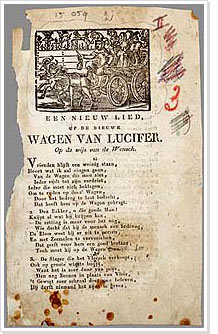Broadside ballads > The broadsides
 Broadsides are single sheets of paper with one or more song lyrics printed on them. In their most elementary form, the sheets are only printed on one side (in broadsheet). If more than one song was printed on a single sheet, the lyrics were placed alongside each other in columns, so the sheet could be cut into strips. But some broadsides were folded in two (resulting in four pages), and there were also instances of loose quires (resulting in eight or sixteen pages).
Broadsides are single sheets of paper with one or more song lyrics printed on them. In their most elementary form, the sheets are only printed on one side (in broadsheet). If more than one song was printed on a single sheet, the lyrics were placed alongside each other in columns, so the sheet could be cut into strips. But some broadsides were folded in two (resulting in four pages), and there were also instances of loose quires (resulting in eight or sixteen pages).
The paper that was used was of poor or mediocre quality. Broadsides were printed by the popular press, which used the cheapest possible printing methods. This type of printing was usually set in gothic type until well into the eighteenth century. There was hardly ever any musical notation, and illustrations (wood carvings) were often re-used. The low cost made these sheets affordable to all.
Little is known about the way in which broadsides were produced: much of the source material has been lost. In the broadside printing process, six roles are of pivotal importance: the author and composer write a lyric and melody; the publisher has the song published; the printer prints it; the vendor sells it, and the singer sings it. Not in all cases were all these roles necessary (an existing melody, for instance, didn't require a composer), and in most cases a single person filled several roles.
